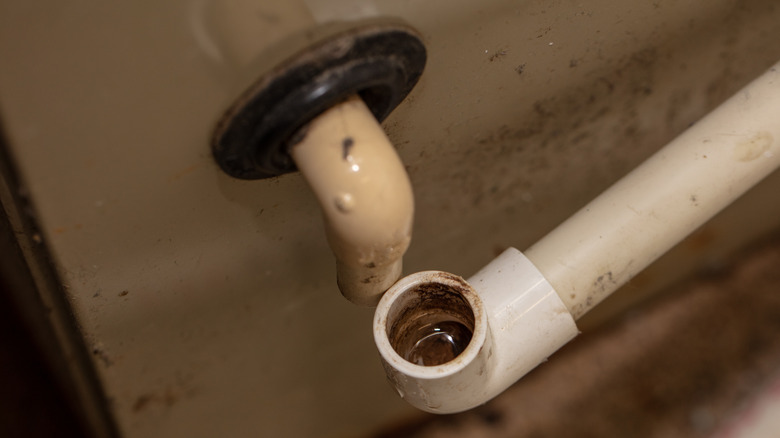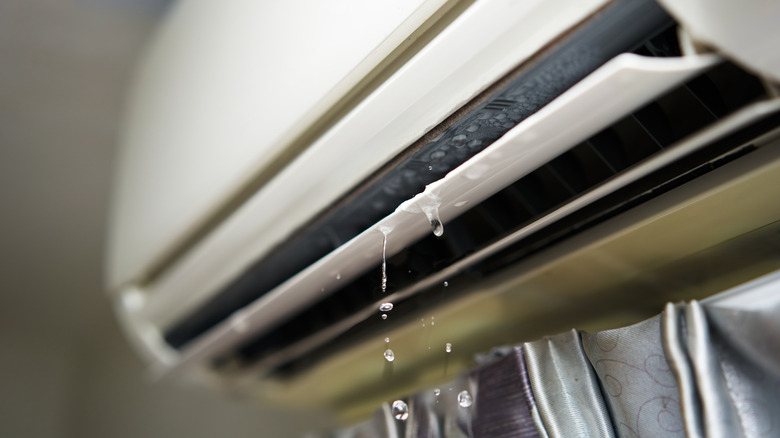The Potential Mold Problem You Should Check For In The Summer & Why
Because they dehumidify the air, air conditioners aren't something we always associate with mold growth in the summer months. Mold is, after all, mainly associated with humidity and warmth. But it's also a problem created and worsened by water intrusion, and some types of air conditioning have a bad habit of splashing down a puddle of water that, if it goes unnoticed, can definitely become a problem in short order. Window units and ventless mini-split air conditioners in particular can periodically cause drips that become wet flooring or walls, and from that point on you're dealing with a real threat of mold growth.
Air conditioners can contribute to mold growth in a couple of other ways as well. While mold is omnipresent in our environments indoors and out, the structure of some systems can cause mold growth in drip pans, fed by household dust that naturally collects in ACs, to get widely distributed in risky quantities. Some of the most common types of mold that can grow in a home can present health risks, and should be evaluated by a professional once you encounter them. When you're on the lookout, remember that there are many unexpected places where mold may be lurking in your home, so check under rugs, behind baseboards, etc.
That steady drip that breaks your condensation
When it comes to AC units and water intrusion, the culprit is most often something you wouldn't even think very likely: a blocked condensate drain line. The condensation that ACs naturally produce (and which is why they have a dehumidifying effect) is normally collected in a pan and carried away by a drain line. Sometimes, these small drain tubes (usually around ¾ inch) will get clogged with biofilm (a mass of living matter that collects and thrives in the condensed water) and/or mold. This causes the condensation to back up and overflow the collection pan.
In outdoor units, this is less of a problem — at least when it comes to mold growth. Certainly, puddling of water outside doesn't create any sort of mold threat any more than rain would. But when those drain pans are indoors (as is the case with mini-split units) or can overflow indoors (which is sometimes the case with window units, especially when they haven't been properly installed), you end up with a puddle of water in your home. Mold might be inhibited by the temperature of the conditioned air, but once that water makes it out of the AC unit, the problem worsens — fast. Mold thrives when surface temperatures are between 68 and 86 degrees... right where you'd expect most household surfaces to fall.
Other AC-related mold problems
There are a couple of other ways in which your HVAC system — and not just window units and mini-splits — can contribute to potential mold issues. These are again related to condensation, but not necessarily related to the condensate drain pan and lines. One issue is when cooled air leaks into an area with much warmer and often more humid air, such as in an attic or crawl space. As that cold air cools nearby surfaces, vapor in the air condenses and becomes a critical source of water for mold growth.
When you have copper refrigerant lines running through your walls and into your home, as is the case with mini-splits, problems with insulation for those lines can also cause condensation and dripping. The most obvious problem comes from missing refrigerant line insulation, which can sometimes happen where the lines exit a unit or enter a wall. The bare, super-cold copper will almost always collect condensation, forming drips somewhere downstream. If the insulation is compressed (again, as when entering a wall or AC unit, as well as when hangers are incorrectly installed), water can condense on the insulation or on nearby surfaces and feed your mold. So, wherever water or refrigerant flows around your air conditioners, keep an eye out for dampness or standing water, and take a good look at possible culprits like clogged drain lines and refrigerant line insulation problems.


